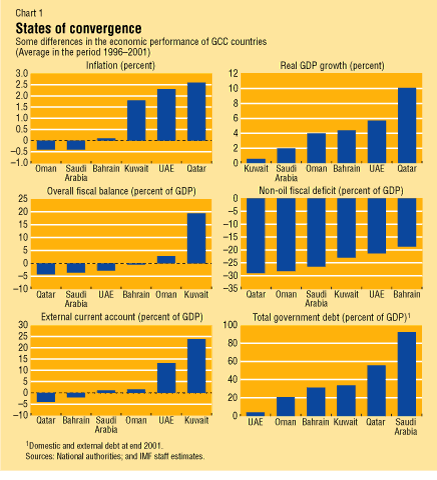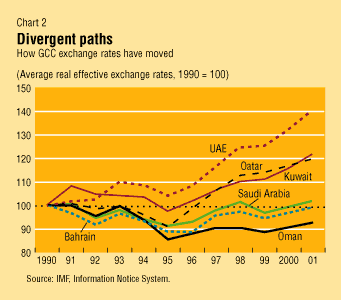Comparing GCC countries
Economic and social indicators vary throughout the Gulf.
(2001 est.)
|
| Country |
Nominal
GDP
(million
dollars) |
Nominal GDP
(per capita
dollars) |
Population
(millions)1 |
Overall
fiscal
balance
(percent
of GDP)2 |
Total
government
debt
(percent
of GDP) |
Proven
oil
reserves
(years)3 |
Central
bank
foreign
assets
(months of
imports)4 |
Life
expectancy
at birth
(years)5 |
Illiteracy
(percent of
population
15+)5 |
|
Bahrain0
Kuwait0
Oman0
Qatar0
Saudi Arabia0
U.A.E.0
GCC |
7,9330
33,8070
19,8960
16,5530
186,4890
69,8710
334,5490 |
11,1620
14,6260
8,0500
27,9170
8,8680
20,0320
12,7086 |
0.70
2.20
2.50
0.60
21.00
3.50
30.50 |
0.20
22.70
4.00
0.10
-3.90
-3.90
-0.46 |
31.10
33.80
20.30
55.60
92.10
4.00
60.76 |
15.00
134.00
16.00
15.00
87.00
124.00
89.76 |
3.00
10.10
4.90
2.70
11.00
4.90
8.86 |
730
770
740
750
730
750
750 |
120
170
280
190
240
250
210 |
1Includes expatriates.
2Includes investment income of government foreign assets.
3Based on current production.
4These figures are not an accurate reflection of the country's foreign asset position because data on government reserves are partial in some GCC countries.
5Latest available information.
6Weighted average.
Sources: National authorities; IMF staff estimates; and World Bank, World Development Indicators, 2001.
|
|
Coming challenges
The GCC countries face dual challenges in the period ahead: reducing vulnerability to oil price fluctuations and accelerating non-oil growth to generate employment opportunities for the rapidly growing domestic labor force. These challenges have to be addressed while ensuring intergenerational economic equity from the exploitation of nonrenewable natural resources—oil and gas. Despite diversification efforts, the oil sector still contributes on average about one-third of GDP and accounts for three-fourths of annual government revenue and export receipts, making the GCC countries vulnerable to oil price fluctuations. In addition, growth of non-oil GDP has been slow in some of these countries, while strains in the employment market for nationals have emerged, with the GCC labor markets remaining segmented between nationals and expatriates. The GCC governments are aware that responses to these challenges call for sustained structural reforms aimed at optimizing market-based resource allocation and private sector-led growth. In fact, GCC countries are currently at various stages of implementing structural and institutional reforms, including lifting impediments to foreign direct investment, streamlining business regulations, expanding private investment opportunities in key sectors, and improving corporate governance.
The planned monetary union of the GCC countries will reinforce the beneficial effects of these reforms and sound macroeconomic policies and help them address the two main challenges. The monetary union is likely to promote policy coordination, reduce transaction costs, and increase price transparency, resulting in a more stable environment for business and facilitating investment decisions. However, although direct gains (such as increased intraregional trade) from the union might be relatively small for these countries, indirect gains could be more important. In particular, the introduction of a common currency is likely to enhance growth prospects by contributing to the unification and development of the region's bond and equity markets and by improving the efficiency of financial services. In contrast, the costs of monetary union to individual countries—such as giving up the ability to set an independent monetary policy and adjust the nominal exchange rate—should not be high because GCC countries have not relied on these tools for quite some time under their pegged exchange rate regimes. Although most GCC currencies have been formally pegged to the IMF's Special Drawing Right (SDR), in practice they have maintained a stable long-term relationship with the U.S. dollar (except for the Kuwaiti dinar, which is pegged to a special weighted basket of currencies of the country's trade and financial partners). Nevertheless, the monetary union will need to be supported by a range of structural reforms to be fully effective.
Regional environment
Amid volatile oil prices, the GCC countries have managed their hydrocarbon wealth well during the past decades under an open exchange and trade system, with liberal capital flows. The proceeds from oil have been used to modernize infrastructure, provide employment, improve social indicators, and accumulate official reserves. External debt has remained relatively low in most GCC countries, inflation has been kept under control, and the exchange rate has been effectively used as a nominal anchor. In addition, since the GCC was established, its members have built on their remarkable degree of cultural, political, demographic, and economic homogeneity to foster economic cooperation and regional integration. Barriers to the free movement of national goods, labor, and capital across the GCC countries have been eliminated, and individuals and corporations in the region have been granted national treatment for tax purposes in each country. The GCC members already satisfy a number of convergence criteria, including stable nominal bilateral exchange rates, and broadly similar monetary policies reflecting open capital accounts and a similar pegged exchange rate regime across the area. Furthermore, important progress has been made toward the establishment of a customs union by early 2003, with all GCC countries already at or below the agreed 5 percent single common external tariff.
Despite this progress toward integration, the six countries continued to exhibit differences in economic performance and policy preferences during the 1990s, particularly in the second half (Chart 1). Though inflation has traditionally been low in the area, it differs across countries, leading to diverging paths for the real effective exchange rates (Chart 2). Real GDP growth disparities have also been observed, particularly of non-oil GDP. Some GCC countries have recorded fiscal deficits, reflecting volatile global oil prices and relatively high levels of expenditure. In the process, government debt has increased considerably in a few GCC countries.


Although monetary policy in the GCC countries has been focused primarily on ensuring price and exchange rate stability, differences remain in the set of monetary instruments they use. Moreover, different bank regulatory practices—particularly regarding entry restrictions, liquidity requirements, loan classification and provisioning, and ownership—have slowed full integration of the region's financial and capital markets. As a result, the structure of the banking system differs across GCC countries. In addition, with the exception of Saudi Arabia, the region's equity markets are still relatively small and underdeveloped. Private securities markets are yet to develop, and barriers still hinder the development of government bond markets. On the institutional front, differences exist in commercial agency laws, industrial licensing, bankruptcy laws or regulations, and government tenders and contracts.
Options for implementation
The GCC countries will need to make fundamental choices in designing an effective monetary union. These interdependent choices involve selecting quantitative convergence criteria; coordinating policies in key areas; designing the institutions to support the union, including the adoption of common monetary instruments; and improving transparency and national data systems. In addition, the implementation of structural reforms that complement convergent macroeconomic policies might go beyond the introduction of a common currency. Progress will also be essential during the transition period in addressing labor market rigidities and strengthening product-market competition.
Designing an effective monetary union will therefore call for decisions on the following:
- adopting clear criteria for fiscal convergence;
- determining the common exchange rate policy, including pooling of foreign reserves, and the irrevocable fixing of bilateral conversion rates;
- developing the institutions, such as a common central bank, to support the monetary union, as well as a common set of instruments to ensure that monetary policy operations have a similar effect throughout the GCC area;
- establishing adequate data quality and common standards to assess progress toward convergence criteria and adherence to policy objectives; and
- implementing structural reforms to complement the monetary union.
Next steps toward a full monetary union
While the above choices must be made before the introduction of a common currency, the pace of these reforms will determine how fast the GCC countries consolidate the economic union and enhance the net benefits of a single currency. In particular, action will be needed in the following areas:
Fiscal convergence. Fiscal discipline is crucial for the success of the monetary union. Without it, large differences in member countries' fiscal stances can create tensions, leading to political disagreement and hindering other key macroeconomic convergence requirements for the smooth functioning of the union, such as price stability. Member countries must therefore be subject to a common code of fiscal conduct—consisting of reference values for fiscal variables, a common accounting framework for computing public finance accounts, and adequate budgetary procedures for maintaining fiscal discipline—with the achievement of fiscal convergence receiving the highest priority before the introduction of the common currency.
Compliance with the chosen fiscal convergence criteria is essential not only by the specific date but also on a sustained basis during the transition to the common currency. Thus, improvements related to one-off measures or a temporary positive terms of trade shock would not be considered sustainable. Moreover, an important aspect of budgetary policy in oil-dependent economies is to ensure an appropriate balance between spending on the present generation and saving for future generations.
Given the GCC countries' dependence on volatile oil revenue and the importance of achieving intergenerational equity, the choice of fiscal convergence criteria is complex. Consequently, the criteria should be applied at various levels. In addition to traditional fiscal convergence indicators, such as ceilings on overall fiscal deficits and government debt—possibly net of certain liquid government assets—the GCC national authorities should also establish targets for member countries' non-oil fiscal deficits to clearly determine underlying fiscal trends; the latter should not be the same for each country because of different hydrocarbon and financial wealth. Moreover, given the volatility in oil prices and, in turn, nominal GDP, GCC countries need to carefully review how these criteria should be measured. But, for operational reasons, they will eventually have to agree on a common indicator that reflects these criteria for fiscal convergence. A coordinated fiscal policy response to shocks might also be needed to avoid endangering the cohesion of the union.
Exchange arrangement. The pegged exchange rate regime in the GCC countries has contributed over the past decades to keeping inflation low, maintaining competitiveness, and strengthening confidence. Thus, the GCC authorities have also decided to peg the common currency to the U.S. dollar to provide a nominal anchor. This choice of exchange rate regime must be supported by a strong fiscal position and a sound banking system. In addition, it must be complemented by structural reforms (see below) and human capital development to boost the economies' flexibility, particularly the labor market for nationals, in order to enhance prospects of developing non-oil activities. However, in light of changing trade patterns over the medium term—with Europe probably gaining in importance through negotiations under way for a trade agreement between the two areas—and structural differences across the GCC countries—notably in hydrocarbon wealth—other options for the exchange rate regime of the common currency could be considered, including pegging to a basket of currencies, or, possibly, other more flexible arrangements. Each option carries its own policy implications and operational requirements.
Other decisions about the exchange arrangement must also be made. These include determining the pooling of each GCC member's foreign reserves, the rate at which to irrevocably fix the bilateral rates, and the adoption of a common definition—based on international standards—of foreign reserves.
Institutional considerations. The creation of a common independent central bank or unified monetary authority would be the most important institutional change on the road toward a monetary union. A single supranational monetary authority with clear responsibility for formulating and conducting monetary policy is needed because decentralized decision making would be counterproductive in the context of a monetary union. The approach used by the European Union to organize central bank responsibilities could be a useful example for the GCC area. Under such an arrangement, the common central bank would be responsible for making monetary policy decisions, overseeing payments systems, and coordinating efforts toward financial integration. For their part, the national GCC central banks or monetary authorities would implement these decisions, conduct all or some of the foreign exchange operations, maintain their banking supervisory functions, issue the common currency, and operate national payments systems.
A common central bank, together with the national central banks, would have to apply common monetary policy instruments and put in place the necessary regulatory, legal, and institutional framework.
Transparency policy and statistical requirements. Assessment of progress toward convergence criteria and adherence to policy objectives requires comparable and transparent macroeconomic and financial statistical information across GCC countries. In particular, as indicated above, the harmonization of fiscal concepts and data based on internationally accepted standards and methods should be given high priority as part of the common code of fiscal conduct.
Structural reforms. Although structural reforms are desirable independent of the introduction of a monetary union, they are likely to enhance the positive effects of the common currency. Thus, the GCC authorities should give priority to improving resource allocation and mobility of production factors and to promoting foreign direct investment. Priority should also be given to reforms that strengthen product-market competition, such as antitrust, commercial, and agency laws and business codes and regulations. Also, progress should be made in harmonizing or coordinating taxation, fiscal incentives, and pension systems. To increase job opportunities for nationals in the private sector, the GCC authorities should rely mainly on improving education and training to match available jobs with skill requirements and make the labor market for nationals more flexible.
To achieve the full integration and deepening of financial markets, a monetary union needs to be complemented by a number of regulatory and legislative adjustments (for example, limits on foreign ownership of stocks) designed to liberalize national financial markets and foster harmonization. Also, increased cross-border banking operations are likely to depend on the degree to which the region's banking systems are liberalized and the legislative, regulatory, and supervisory frameworks harmonized. The experience with European monetary union shows that the introduction of the euro, while fostering more liquid bond and equity markets, has not eliminated all barriers to financial market integration because of differences in tax, accounting, and legal frameworks, and a lack of fully integrated clearing and settlement systems.
References:
Alberto Alesina and Robert J. Barro, 2001, Currency Unions (Stanford, California: Hoover Institution Press, Stanford University).
Mario I. Blejer, Jacob A. Frenkel, Leonardo Leiderman, and Assaf Razin (eds.), 1997, "Optimum Currency Areas: New Analytical and Policy Developments" (Washington: International Monetary Fund).
Mohamed A. El-Erian and Stanley Fischer, 1996, "Is MENA a Region? The Scope for Regional Integration," IMF Working Paper 96/30 (Washington).
Javier Santill�n, Marc Bayle, and Christian Thygesen, 2000, "The Impact of the Euro on Money and Bond Markets," European Central Bank Occasional Paper No. 1, July (Frankfurt, Germany).
|
Zubair Iqbal is Assistant Director of the IMF's Middle Eastern Department; Ugo Fasano is a Deputy Division Chief in the Department.
|
|
